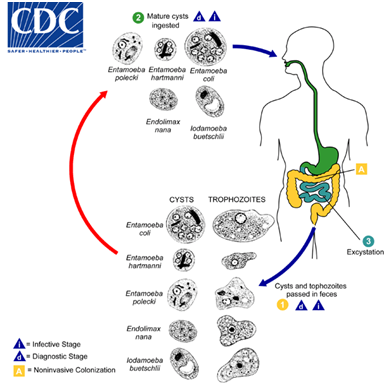|
Chromatoidal Bodies
Chromatoidal bodies are aggregations of ribosomes found in cysts of some amoebae including ''Entamoeba histolytica'' and ''Entamoeba coli ''Entamoeba coli'' is a non-pathogenic species of ''Entamoeba'' that frequently exists as a commensal parasite in the human gastrointestinal tract. ''E. coli'' (not to be confused with the bacterium ''Escherichia coli'') is important in medicine ...''. They exist in the cytoplasm and are dark staining. In the early cystic stages of ''E. histolytica'', chromatid bodies arise from aggregation of ribosomes forming polycrystalline masses. As the cyst matures, the masses fragment into separate particles and the chromatoidal body disappears. It is thought that the chromatoidal body formation is a manifestation of parasite-host adaptive conditions. Ribonucleoprotein is synthesized under favorable conditions, crystallized in the resistant cyst stage and dispersed in the newly excysted amoebae when the amoeba is able to establish itself in a new host. ... [...More Info...] [...Related Items...] OR: [Wikipedia] [Google] [Baidu] |
Ribosomes
Ribosomes ( ) are macromolecular machines, found within all cells, that perform biological protein synthesis (mRNA translation). Ribosomes link amino acids together in the order specified by the codons of messenger RNA (mRNA) molecules to form polypeptide chains. Ribosomes consist of two major components: the small and large ribosomal subunits. Each subunit consists of one or more ribosomal RNA (rRNA) molecules and many ribosomal proteins (RPs or r-proteins). The ribosomes and associated molecules are also known as the ''translational apparatus''. Overview The sequence of DNA that encodes the sequence of the amino acids in a protein is transcribed into a messenger RNA chain. Ribosomes bind to messenger RNAs and use their sequences for determining the correct sequence of amino acids to generate a given protein. Amino acids are selected and carried to the ribosome by transfer RNA (tRNA) molecules, which enter the ribosome and bind to the messenger RNA chain via an anti-cod ... [...More Info...] [...Related Items...] OR: [Wikipedia] [Google] [Baidu] |
Amoebae
An amoeba (; less commonly spelled ameba or amœba; plural ''am(o)ebas'' or ''am(o)ebae'' ), often called an amoeboid, is a type of cell or unicellular organism with the ability to alter its shape, primarily by extending and retracting pseudopods. Amoebae do not form a single taxonomic group; instead, they are found in every major lineage of eukaryotic organisms. Amoeboid cells occur not only among the protozoa, but also in fungi, algae, and animals. Microbiologists often use the terms "amoeboid" and "amoeba" interchangeably for any organism that exhibits amoeboid movement. In older classification systems, most amoebae were placed in the class or subphylum Sarcodina, a grouping of single-celled organisms that possess pseudopods or move by protoplasmic flow. However, molecular phylogenetic studies have shown that Sarcodina is not a monophyletic group whose members share common descent. Consequently, amoeboid organisms are no longer classified together in one group.Jan Pawlowski ... [...More Info...] [...Related Items...] OR: [Wikipedia] [Google] [Baidu] |
Entamoeba Histolytica
''Entamoeba histolytica'' is an anaerobic parasitic amoebozoan, part of the genus ''Entamoeba''. Predominantly infecting humans and other primates causing amoebiasis, ''E. histolytica'' is estimated to infect about 35-50 million people worldwide. ''E. histolytica'' infection is estimated to kill more than 55,000 people each year. Previously, it was thought that 10% of the world population was infected, but these figures predate the recognition that at least 90% of these infections were due to a second species, ''E. dispar''. Mammals such as dogs and cats can become infected transiently, but are not thought to contribute significantly to transmission. The word '' histolysis'' literally means disintegration and dissolution of organic tissues. Transmission The active (trophozoite) stage exists only in the host and in fresh loose feces; cysts survive outside the host in water, in soils, and on foods, especially under moist conditions on the latter. The infection can occur when a ... [...More Info...] [...Related Items...] OR: [Wikipedia] [Google] [Baidu] |
Entamoeba Coli
''Entamoeba coli'' is a non-pathogenic species of ''Entamoeba'' that frequently exists as a commensal parasite in the human gastrointestinal tract. ''E. coli'' (not to be confused with the bacterium ''Escherichia coli'') is important in medicine because it can be confused during microscopic examination of stained stool specimens with the pathogenic ''Entamoeba histolytica''. This amoeba does not move much by the use of its pseudopod, and creates a "''sur place'' (non-progressive) movement" inside the large intestine. Usually, the amoeba is immobile, and keeps its round shape. This amoeba, in its trophozoite stage, is only visible in fresh, unfixed stool specimens. Sometimes the ''Entamoeba coli'' have parasites as well. One is the fungus ''Sphaerita'' spp. This fungus lives in the cytoplasm of the ''E. coli''. While this differentiation is typically done by visual examination of the parasitic cysts via light microscopy, new methods using molecular biology techniques have been deve ... [...More Info...] [...Related Items...] OR: [Wikipedia] [Google] [Baidu] |

